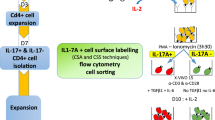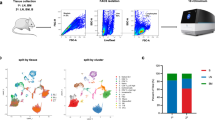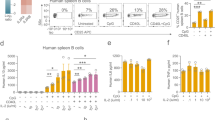Abstract
Medium conditioned by lectin (and/or antigen)-stimulated human peripheral blood lymphocytes has been shown to contain factors, termed interleukin 1 (IL-1) and interleukin 2 (IL-2)1,2, which augment and maintain human T-cell proliferation3–6, respectively. Interleukin 2 (T-cell growth factor, TCGF) requires the presence of a macrophage, or its monokine product, IL-1, for its production by T cells7–9. It has been shown that multiple signals are required for stimulating both T- and B-cell proliferation8–10 but the factors necessary for optimal B-cell mitogenesis have not been rigorously defined. As both B- and T-cell stimulatory agents are present in lectin-stimulated peripheral blood lymphocyte-conditioned media, we studied the effects of the interleukin factors on human B cells. Human peripheral blood B lymphocytes and pokeweed mitogen (PWM)-stimulated B-cell blasts were evaluated for their proliferative response to soluble growth factors, which were obtained from either lipopolysaccharide or phytohaemagglutinin (PHA)-stimulated peripheral blood mononuclear cells. We show here that factors from lipopolysaccharide-stimulated conditioned medium were unable to stimulate initial B-cell proliferation. However, factors from PHA-stimulated conditioned medium stimulated 3H-thymidine (TdR) incorporation in both B cells and lectin-activated T cells. This stimulation could be maintained for multiple re-exposures to the growth factors, which suggests that a soluble factor present in medium conditioned by lectin-stimulated peripheral blood mononuclear cells may modulate B-cell proliferation in a manner analogous to T-cell proliferation.
This is a preview of subscription content, access via your institution
Access options
Subscribe to this journal
Receive 51 print issues and online access
$199.00 per year
only $3.90 per issue
Buy this article
- Purchase on Springer Link
- Instant access to full article PDF
Prices may be subject to local taxes which are calculated during checkout
Similar content being viewed by others
References
Aarden, L. A. et al. J. Immun. 123, 2928–2929 (1979).
Diamanstein, T. et al. Cell. Immun. 46, 422–425 (1979).
Morgan, D. A., Ruscetti, F. W. & Gallo, R. C. Science 193, 1007–1008 (1976).
Gillis, S. & Smith, K. D. Nature 268, 154–155 (1977).
Maizel, A. L. et al. J. Immun. 127, 1058–1064 (1981).
Coutinho, A., Larsson, E.-L., Gronvik, K. O. & Andersson, J. Eur. J. Immun. 9, 587–592 (1979).
Gillis, S. & Mizel, S. B. Proc. natn. Acad. Sci. U.S.A. 78, 1133–1137 (1981).
Smith, K., Lachman, L., Oppenheim, J. & Fevata, M. J. exp. Med. 151, 1551–1556 (1980).
Larsson, E.-L., Ifcove, N. & Coutinho, A. Nature 283, 664–666 (1980).
Rosenberg, S. A. & Lipsky, P. E. J. Immun. 122, 926–931 (1979).
Bird, A. G., Hammarstrom, L., Smith, C. & Britton, S. Clin. exp. Immun. 43, 165–173 (1981).
Lachman, L. B., Page, S. O. & Metzger, R. S. J. supramotec. Struct. 13, 457–466 (1980).
Maizel, A. L., Mehta, S., Ford, R. J. & Lachman, L. B. J. exp. Med. 153, 470–475 (1981).
Mier, J. W. & Gallo, R. C. Proc. natn. Acad. Sci. U.S.A. 77, 6134–6138 (1980).
Jerrels, T. R., Dean, J. H., Richardson, G. L. & Herberman, R. B. J. Immun. Meth. 32, 11–29 (1980).
Bonnard, G. D., Yasaka, K. & Jacobson, D. J. Immun. 123, 2704–2708 (1979).
Smith, K. A. Immun. Rev. 51, 337–357 (1980).
Greaves, M., Janossy, G. & Doenhoff, M. J. exp. Med. 140, 1–15 (1974).
Fauci, A. S. & Pratt, K. D. J. exp. Med. 144, 674–681 (1976).
Janossy, G. & Greaves, M. Transplant Rev. 24, 176–204 (1975).
Lipsky, P. D. J. Immun. 125, 155–162 (1980).
Chiorazzi, N., Fu, S. M. & Kunkel, H. G. J. exp. Med. 149, 1543–1548 (1979).
Geha, R. S. Immun. Rev. 45, 275–305 (1979).
Schimpl, A. & Wecker, E. Nature new Biol. 237, 15–18 (1972).
Reinherz, E. L., Kung, P. C., Breard, J. M., Goldstein, G. & Schlossman, S. F. J. Immun. 124, 1883–1887 (1980).
Hoffman, M. K. Ann. N. Y. Acad. Sci. 332, 557–563 (1979).
Hoffman, M. K. J. Immun. 125, 2076–2081 (1980).
Maizel, A. L., Mehta, S. & Ford, R. J. Cell. Immun. 48, 383–397 (1979).
Author information
Authors and Affiliations
Rights and permissions
About this article
Cite this article
Ford, R., Mehta, S., Franzini, D. et al. Soluble factor activation of human B lymphocytes. Nature 294, 261–263 (1981). https://doi.org/10.1038/294261a0
Received:
Accepted:
Issue Date:
DOI: https://doi.org/10.1038/294261a0
This article is cited by
-
Administration of recombinant IL-2 augments the level of serum IgM in an IL-2 deficient patient
European Journal of Pediatrics (1989)
-
Production of lymphokines by HBsAg-reactive human T cell clones upon antigenic stimulation
Gastroenterologia Japonica (1987)
-
T cell-derived B cell growth and differentiation factors
La Ricerca in Clinica e in Laboratorio (1987)
-
Establishment of spontaneously outgrowing lymphoblastoid cell lines with Cyclosporin A
Medical Microbiology and Immunology (1983)
-
Kinetics of induction and molecular size of mRNAs encoding human interleukin-2 and γ-interferon
Nature (1982)
Comments
By submitting a comment you agree to abide by our Terms and Community Guidelines. If you find something abusive or that does not comply with our terms or guidelines please flag it as inappropriate.



